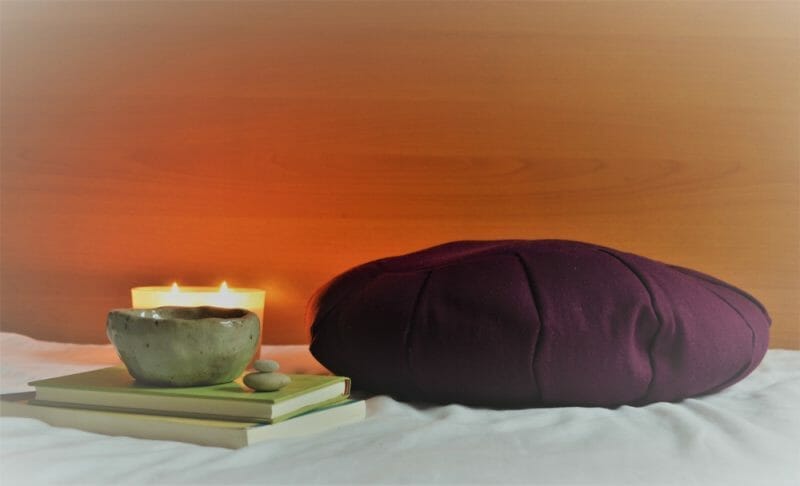A zafu is a small round (sometimes rectangular, too) cushion used in Zen meditation. It is used to sit on top of a zabuton meditation mat.
Sometimes it is referred to as a knee pillow as well.
In some styles of meditation, you sit on a zafu and rest your buttocks on the zabuton. In other styles, you sit upright on the zafu, so your knees touch the ground.
I’ll cover all the basics about zafu in this post and help you decide if it’s right for you.
What Is a Zafu Meditation Cushion?
A zafu meditation cushion is a round cushion filled with kapok or buckwheat that is used for Buddhist meditation.
Zafus and zabuton can be stuffed with kapok, buckwheat, cotton, wood shaving and synthetic stuffing and take the form of round seats or floor cushions.
Kapok is a cotton-like material derived from the seed pods of the Kapok tree. It is very light and provides firm support.
Nowadays, meditation cushions are specifically designed to provide comfort and stability to new meditators.
A Zafu is an important part of the personal religious and spiritual practice of many Zen practitioners.
Although there are many different types of meditation and practices that use a zafu, Zen meditation is the main reason the zafu exists and has its shape and design.
Zafus (round pillows) and zabuton (flat floor cushions) are used in Zen practice to support the meditator’s buttocks and knees and to elevate the hips.
Each zafu is slightly larger than the user’s hips and should be placed between the knees with the knees slightly open.
It is thick enough to make you comfortable. Sitting on a zafu helps a meditator to sit in the correct posture. The zafu helps in keeping the spine straight and letting the body feel comfortable.
Zafus typically measure one foot in diameter and two to five inches tall.
Take a look at the collection of zafus on Amazon. They have good reviews from real-life users.
What Does Zafu Mean?
Zafu comes from the Japanese word meaning ‘sitting cushion’ or ‘sewn seat’. It is used in the Japanese custom of “zazen”, which is the typical Japanese method of meditation.
The zafu is usually placed on top of the zabuton mat.
The zazen practitioners typically sit on the zafu rather than on the floor, ground, or a chair.
How a Zafu Works
A zafu (or zabuton) will help you to concentrate during meditation and reduce the pressure on your knees and back.
There’s a fabric cover and a soft surface underneath Zafu so that the floor is not directly contacted. You can also place a zabuton mat under your zafu.
Why You Should Use Zafus
Zafu is great for any yogi or person that is into meditation.
Whether you’re practicing meditation or yoga, the right equipment can make a world of difference.
Zafus are filled with buckwheat hulls or cotton. The hulls conform to the shape of your body and evenly distribute body weight and pressure, relieving pressure points and giving you amazing support and stability. And this is what makes a zafu such a comfortable meditation seat.
It is placed underneath the buttocks and the spine to support the body in the traditional cross-legged position during zazen meditation.
As a traditional Japanese meditation cushion, zafu has proven its usefulness over time when it comes to practicing sitting meditation. It has the perfect firmness.
It enables the practitioners to sit in the cross legged position for long hours. As compared to other cushions, it helps in achieving maximum concentration.
Zafus are a good size for all body types and allow you to sit comfortably without getting tired. This way, you can spend more time doing your mediation.
There are many people who are uncomfortable sitting on the bare floor. A zafu is very comfortable and far better than the conventional method of sitting on the ground.
Moreover, the zafus come in a variety of different colors and you can choose the color and design that appeals to you the most.
Why Are Zafus So Expensive?
Zafus are probably among the most expensive yet important tools of Zen meditation.
Zen centers sell zafus and zabutons, as well as many Buddhist supply vendors. They are quite pricey, though! Many people buy them from Buddhist supply stores, but I prefer to make my own.
Buying them straight from a zen center or Buddhist meditation supply store can cost anywhere from $50-$150 per set.
Zafus are niche products catering to a very niche market. It’s trendy, for one thing. There is a growing trend of mindfulness practice in the USA. The market is small, but it’s growing.
A large part of it is supply and demand. There aren’t many places to buy them, so it’s a seller’s market, so prices are high.
The Buddhist community is not a huge community in the USA and Europe, so there is not a big enough customer base for them to sell for market costs.
There’s nothing wrong with criticizing companies that sell at a premium, however sometimes we need to look at the other side.
Zafus are more expensive when they are made in the USA.
You can buy a zafu online and get it shipped to your house.
They’re a specialty item, and not a commodity good. If you’re a specialty goods retailer, you price goods at a premium.
Also, many zafu makers are Buddhist practitioners, and take great care in their product, aiming to provide a premium product.
So, it is common for some zafus to be more expensive due to their handcrafted nature.
Parting Words
One of the most important things that a meditator can have is a comfortable meditation cushion.
Meditation cushions or zafus are designed to promote good sitting (“zazen”) posture and can be used to cushion and elevate your sitting bones and hips.
There are many different types of zafus out there. If you are just starting out, it can be difficult to choose the best equipment for your needs.

